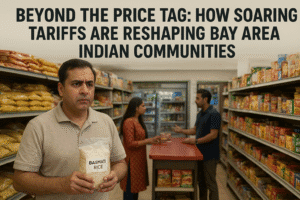Beyond the Price Tag: How Soaring Tariffs Are Reshaping Bay Area Indian Communities
Soaring U.S. tariffs on Indian imports, now at 25% and threatening to hit 50% by August 27th, are severely impacting Bay Area Indian restaurants and grocers. Businesses like New India Bazar and Shanvi Indian Kitchen are forced to raise prices 10-20% immediately on essentials like basmati rice, lentils, and irreplaceable spices, shocking customers with suddenly higher bills. Owners absorb some costs but face impossible choices as margins vanish.
The tariffs uniquely hurt this community because key items like authentic basmati rice and spices (a $410 million import) simply cannot be sourced domestically. Businesses from acclaimed importer Diaspora Co. – facing $200,000 in tariffs erasing profits – to Vik’s Chaat warn they cannot sustain these costs long-term without drastic measures. The threatened 50% tariff would force even steeper price hikes, risking menu changes, quality compromises, and potential closures. This high-stakes trade policy directly threatens the affordability of cultural staples and the survival of cherished local businesses built over generations.

Beyond the Price Tag: How Soaring Tariffs Are Reshaping Bay Area Indian Communities
The vibrant aromas of cumin, cardamom, and turmeric wafting through Bay Area Indian grocers and restaurants now carry an added, bitter note: the escalating cost of U.S. tariffs on Indian imports. What began as a 25% levy on August 7th, imposed by the Trump administration as a sanction for India’s Russian oil purchases, threatens to cripple local businesses and reshape cultural access for the region’s Indian diaspora. With President Trump threatening an increase to 50% if no agreement is reached by August 27th, the anxiety is palpable.
From Distributor to Dinner Plate: The Immediate Sting
For Vikas Aggarwal, owner of Shanvi Indian Kitchen & Grocery in Alameda, the tariffs translated directly into updated price tags during a recent lull. Basmati rice, essential spices, and frozen naan now cost customers 10%-20% more. “Now even the invoices mention to ‘please increase prices at the store,’” Aggarwal shared, highlighting the direct pressure distributors face and pass on. Customers are noticing immediately: “They’ll tell me… ‘last time a product was $2.99, why is it $3.50 now?’”
At San Francisco’s historic New India Bazar, co-owner Nitin Bhatt faces the same harsh reality. An $800 order arrived with an $80 tariff fee explicitly itemized. While Bhatt tries to soften the blow – raising a bag of lentils by 40 cents instead of the needed 50 – the cumulative effect stings. “It comes as a shock to them that they will be buying the same amount of items, but the total bill has gone up by a lot,” he explained. His father, Auro Bhatt, grimly predicts a stalemate: “No deal could be signed before the deadline… India has also got a very strong stance.”
The Inventory Squeeze and the Inevitable Pass-Through
Amod Chopra, operating Berkeley’s iconic Vik’s Chaat alongside a wholesale business, initially absorbed the cost using inventory purchased under lower tariffs. That buffer is now gone. “I don’t have 10%, 25% or 50% in my margins to just eat that cost,” Chopra stated bluntly. “When the previous inventories deplete, you have no choice.” He recently paid $6,600 in tariffs on a $66,000 shipment – a fee that would have ballooned to $16,500 under the new 25% rate. The lag time of sea freight (around 40 days from India) means the full impact of the latest hike is still washing ashore.
Unique Products, Impossible Choices: Beyond Simple Economics
The crisis exposes the irreplaceable nature of many Indian imports:
- The Spice Dilemma: India is the world’s largest spice exporter. The U.S. simply lacks the tropical climate to grow cinnamon, cloves, or nutmeg domestically. Spice imports from India topped $410 million in 2024.
- The Basmati Imperative: Chef Srijith Gopinathan (Copra) emphasized, “You cannot get Basmati rice from a different country.” Like Champagne, it’s a geographically protected product intrinsic to Indian cuisine. “It has to be from India.”
- Cultural Staples: From specific lentils (dals) and dosa batter to religious items, these goods aren’t just commodities; they’re threads in the fabric of community and cultural identity.
Small Businesses Facing Existential Threats
The human and entrepreneurial cost is stark:
- Diaspora Co., an acclaimed Oakland-based ethical spice importer, was on track for its first profit in three years. Founder Sana Javeri Kadri now estimates $200,000 in tariffs this year – effectively erasing their profit margin. Facing 50% tariffs, they plan a radical transparency: showing customers the exact tariff cost per item (e.g., +$1.50 on a tin of pepper). “We so deeply don’t want to pass on prices to consumers,” Javeri Kadri lamented from Mumbai. “It really is a lose-lose.”
- New India Bazar and Shanvi represent generations of family investment and community service, now jeopardized by forces far beyond their control.
The Looming Shadow: 50% and Community Impact
The threatened jump to 50% tariffs isn’t abstract. It means:
- Dramatic Price Hikes: Essentials like lentils, rice, and spices could see prices soar beyond what many families can regularly afford.
- Menu Changes & Quality Compromises: Restaurants like Copra and Vik’s Chaat may be forced to simplify dishes, reduce portions, or seek inferior substitutes for authentic ingredients, diluting the culinary experience.
- Business Closures: Marginal operations, especially smaller grocers or newer restaurants, may not survive the prolonged margin crush.
A Community Holds Its Breath
As the August 27th deadline approaches, Bay Area Indian business owners watch nervously. The tariffs are no longer a distant trade policy; they are invoices with stark new line items, confused and frustrated customers at the checkout, and the terrifying prospect of decades of hard work unraveling. The outcome of high-stakes diplomacy will directly determine whether families can afford their traditional staples, whether beloved restaurants can maintain their authenticity, and whether unique small businesses built on cultural connection can endure. The cost is being counted not just in dollars, but in the very fabric of a vibrant community.
You must be logged in to post a comment.